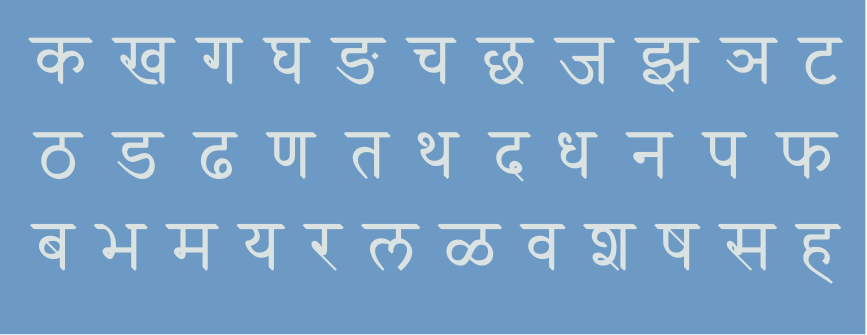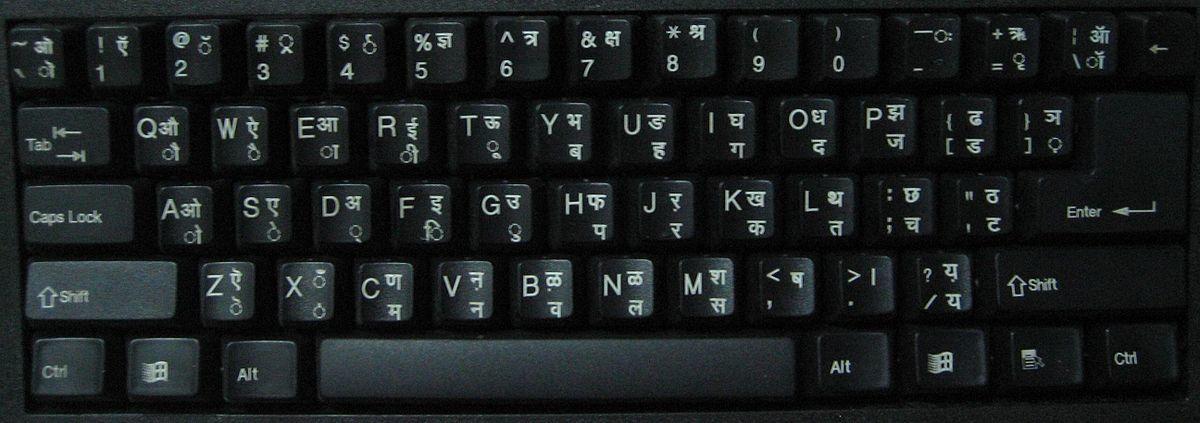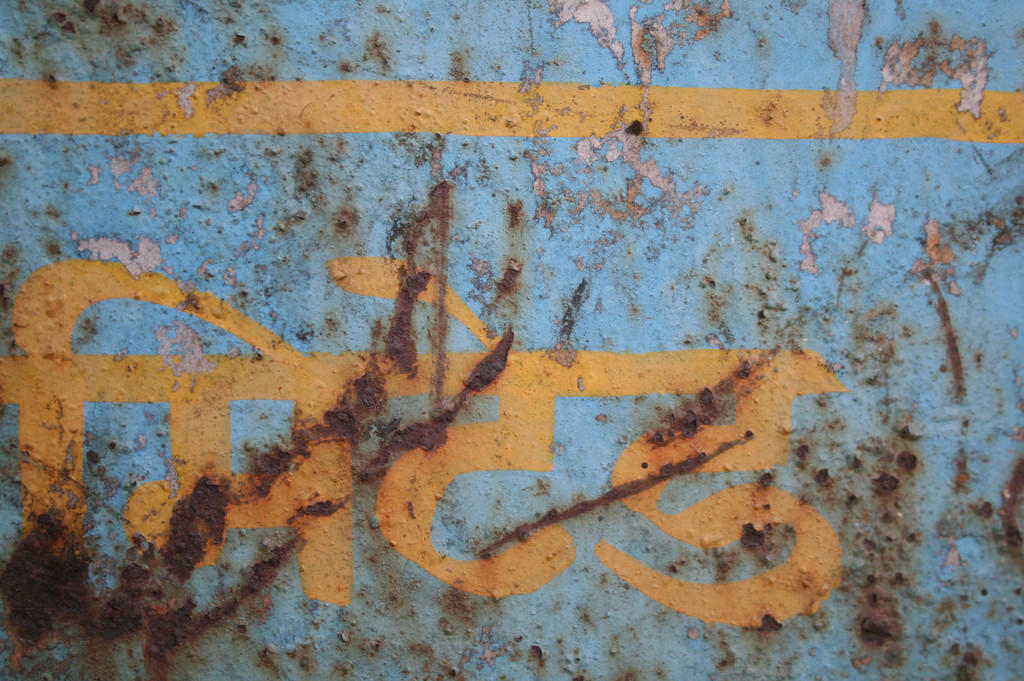Devanagari is a left-to-right abugida script used to write Sanskrit, Hindi, Marathi, Nepali, and other languages. It is based on the ancient Brahmi script and is one of the most widely used writing systems in India
So you have decided to take the plunge and learn how to speak Hindi. You are eager to discover Indian culture and want to learn about Devanagari & Hindi?
But of course, you can learn to speak Hindi - but you also need to learn to read and write it.
So come and discover the Hindi alphabet with us!

Devangari Lipi - History
The Devanagari lipi (Script), also known as Nagari, originated in the 7th century CE as an evolution of the Gupta script, along with the closely related ancient ??rad? and Siddham?tr?k? scripts. It matured around the 13th century CE.
Although its primary use was for inscriptions and religious manuscripts in Sanskrit, Devanagari was also employed for writing vernacular languages in much of northern, northwestern, and western India.
In line with the customs of pre-modern India, multiple scripts were utilized in these written traditions. For instance, the cursive Mo?? script was used for scribal Marathi, while Devanagari was used for Marathi inscriptions. Generally, Devanagari was preferred for non-scribal purposes, as local cursive scripts were more suitable for quickly writing large volumes of text by hand. Before the advent of printing, Devanagari was almost exclusively used for formal texts, which were composed by scribes. Manuscripts, written with reed pens, were the main medium for Devanagari writing.
Nowadays, the Devanagari script is employed for writing three main languages: Hindi (with over 520 million speakers), Marathi (with over 83 million speakers), and Nepali (with over 14 million speakers). Overall, Devanagari is the most commonly used Brahmic script globally, with millions of people using it for reading and writing every day.
How Do You Write in Hindi?
Hindi is written using an alphabet called Devanagari. It is only one of many scripts in India.
Hindi, alongside English, is recognized as an official language by the Government of India, while Nepali holds the status of the sole official language of Nepal and is also an official language in the Indian state of Sikkim. Marathi is the official language of the Indian state of Maharashtra and is also co-official in Goa. Sanskrit, the primary Hindu liturgical language, is typically written in Devanagari script, even in regions where the local language does not use this script.
In India, Hindi holds official status in states such as Uttar Pradesh, Bihar, Rajasthan, Haryana, Himachal Pradesh, Madhya Pradesh, Chhattisgarh, Jharkhand, Uttarakhand, and the National Capital Territory of Delhi. Additionally, Hindi is utilized by central government institutions throughout India and is widely taught and spoken as an additional language in states where Hindi is not the primary language.
Devanagari script is also employed for non-standardized languages that are constitutionally recognized by the Indian Government, including Bodo, Maithili, Kashmiri, Sindhi, Dogri, and Konkani.
Many Indian languages have their own script. While Hindi is an official language of India, so are many others - the government of India has issued a list of several dozen recognized languages, many of which have their own writing system.
So if you decide to learn Punjabi, you could write in either Shahmukhi or Gurmukhi. Gujarati has its script, as does Telugu, Kannada, Sinhalese (Sinhala), Tamil, and Odia. Nepali also has its alphabet, though it can be written in Devanagari.
Though separate scripts, Bengali and Assamese are very similar to Devanagari, being all derived from Brahmic scripts.
The word “Devanagari” comes from the word “Nagari” (older versions of the script go by that name) which means “city”, and “deva” meaning “holy, heavenly”.
It is a Brahmic script - a family including several of the Indian scripts, as well as alphabets from Nepal, Tibet, and Southeast Asia.
Brahmic Scripts
The origins of the Brahmic scripts is still debated. Some believe they may derive from Aramaic, others from Phoenician, still others postulate an indigenous origin from this Indic script.
The earliest-known examples of a Brahmic inscription are Prakrit texts dating to the 3rd to 1st century BC. Brahmic scripts were first used to write Sanskrit in the 1st century BC. Examples of Brahmi can be found throughout northern and central India.
The Gupta script
The Gupta Brahmi Script is first attested around the 1st century AD, mostly on pillars of iron or stone, and on coins minted by the Gupta Empire of India.
It was further developed into the Nagari, Sharada and Siddham scripts.
The Nagari Script
By the 7th century AD, Nagari was in common use to write Prakrit and Sanskrit; by the end of the first millennium AD, it had evolved into Devanagari and Nandinagari (one of the Hindi alphabets used in central and south India, and that has also been used for Sanskrit.)
The Devanagari script is used for the Hindi language, but also more than 120 others. A few of the Indian languages that use Devanagari are:
- Hindi
- Bhojpuri
- Bodo
- Chhattisgarhi
- Dogri
- Haryanvi
- Kashmiri
- Konkani
- Marathi
- Maithili
- Nepali
- Newar
- Pali
- Rajasthani
- Sanskrit
- Santali
- Sindhi
Are you looking for Hindi classes? on Superprof you can find the best Hindi tuition near me and study Hindi language with native speakers.

Basics of the Hindi Alphabet
Hindi is an alphabet writing based on the abugida system in which consonants are the main element, with vowel notation being secondary.
While in the English alphabet (derived from Latin), vowels and consonants have an equal importance, the Hindi alphabet writing uses modifications of the consonants to indicate vowel sounds.
There are separate vowel letters, but they are only used if the vowel:
- stands on its own or
- is at the beginning of the word.
Otherwise, vowels are indicated with a diacritic modification to the basic consonant.
Hindi transliteration
Transliteration is a means of bringing a language with another system of writing into the Latin script.
While there is an internationally recognised standard for transliterating Sanskrit, there is no true standard to approximate how Hindi is pronounced.
This is why it is so important to know the Hindi letters when learning Hindi.
If you can, it is useful to learn the international phonetic alphabet. If you click on one of the symbols on this site, you can hear it spoken, making it easier to learn the consonants and vowels with the right pronunciation.
Use Bollywood movies to learn Hindi and have fun at the same time.
The Hindi Vowels
Each of the Hindi vowels exists as a standalone letter. However, they are only used to write Hindi words if the vowel:
- stands alone (as the name suggests)
- is at the beginning of a word.
There is generally a long and a short version of each of the vowels - a difference that becomes important once you start to pronounce Hindi. The long versions generally take the symbols for the shorter version but add on to it with one or more extra strokes.
The Hindi vowels, known as 'स्वर' (Swar), include:
- अ (a) The most basic vowel sound in Hindi.
- आ (aa) Represents a longer 'a' sound.
- इ (i) A short vowel sound similar to 'i' in 'bit'.
- ई (ee) A longer version of 'इ' with an 'ee' sound like in 'meet'.
- उ (u) A short sound similar to 'u' in 'put'.
- ऊ (oo) A longer version of 'उ' with an 'oo' sound like in 'boot'.
- ऋ (r) A unique sound not present in English, similar to 'ri' in 'river'.
- ए (e) Similar to the 'e' in 'they'.
- ओ (o) Similar to the 'o' in 'go'.
- अं (am) A nasal sound present in several Hindi words.
- अः (ah) Represents a visarga sound, often indicated in poetic contexts.
Find out more about Hindi classes
The Hindi Consonants
Each Hindi consonant, in its independent form, automatically comes with the short version of the vowel “a” attached to it. Here is a list of Hindi consonants:

From left to right:
- ka
- kha
- qa
- gha
- na
- ca
- cha
- ja
- jha
- ña
- ?a
- ?ha
- ?a
- ?ha
- ?a
- ta
- tha
- da
- dha
- na
- pa
- pha
- ba
- bha
- ma
- ya
- ra
- la
- lha
- va
- ?a
- ?a
- sa
- ha
You can hear them pronounced at Wikimedia Commons.
If, however, a vowel other than the short “a” follows the consonant in Hindi nouns or adjectives or verbs, then a so-called diacritic is added to the consonant sign, modifying it slightly.
Here is how the consonant ka is modified depending on which vowel succeeds it:

From left to right:
- ka
- k?
- ki
- k?
- ku
- k?
- k?
- k?
- ?
- kai
- k?
- kau
The top line
A characteristic of Hindi writing is the horizontal line along the top of the words. When writing by hand it is often left out or written last, but it’s always present in print form. When writing down your Hindi vocabulary in your notebook or flashcards, you should try and include it so you can recognise the words better when you see them printed in a sentence.
Ligatures
Certain consonant clusters that appear often are grouped into ligatures - think of how English has æ as a ligature of a and e in certain words. The vowels between these consonants are often suppressed, so only the consonants appear in the ligature.

New World Encyclopedia has a great article that shows some of the most common ligatures.
How do you say 100 in Hindi?
In Hindi, the cardinal number for 100 is ?? (sauv, pronounced S-Au) but the ordinal number for 100 is ????? (sauva?, pronounced as S-au-vn)
Numbers In Hindi 1 to 50 (Cardinal Numbers & Words)
The number names in Indian numerals are written in the cursive Devnagari script and are modeled on the Indian-Arabic numerals. Learn how to count items or money in Hindi with the help of these tables.

How Do You Write 1-10 In Hindi? - 1 ?? 10 ????? ???? ???? ??????
| Number | गिनती (Hindi Ginti) | शब्दों में (In Hindi Words) | in words | ordinal |
|---|---|---|---|---|
| 1 | १ | एक ek | one | पहला |
| 2 | २ | दो do | two | दूसरा |
| 3 | ३ | तीन teen | three | तीसरा |
| 4 | ४ | चार char | four | चौथा |
| 5 | ५ | पाँच pāṅc | five | पाँचवाँ |
| 6 | ६ | छ: chhah | six | छठवाँ |
| 7 | ७ | सात saat | seven | सातवाँ |
| 8 | ८ | आठ āṭh | eight | आठवाँ |
| 9 | ९ | नौ nau | nine | नौवाँ |
| 10 | १० | दस dus | ten | दसवाँ |
10 ?? ????? ??? ???? ????? ???? (How do you write 10 in Hindi?) - The number 10 in Hindi is written as "??" (das). It is pronounced as "dus". The word "??" is derived from the Sanskrit word "??" (da?a), which also means "ten".
Hindi Numbers 11-20 (?????? se ???)
| Number | गिनती (Hindi Ginti) | शब्दों में (In words) | Pronounciation |
|---|---|---|---|
| 11 | ११ | ग्यारह eleven | gya+rah ग्या+रह |
| 12 | १२ | बारह twelve | ba+rah बा+रह |
| 13 | १३ | तेरह thirteen | te+rah ते+रह |
| 14 | १४ | चौदह fourteen | chau+dah चौ+दह |
| 15 | १५ | पंद्रह fifteen | pand+rah पंद्+रह |
| 16 | १६ | सोलह sixteen | sol+ah सोल+ह |
| 17 | १७ | सत्रह seventeen | satrah सत्+रह |
| 18 | १८ | अठारह eighteen | atha+rah अठा+रह |
| 19 | १९ | उन्नीस nineteen | unn-ees उन्नीस |
| 20 | २० | बीस twenty | bees बीस |
15 ?? ????? ??? ???? ??? ???? ????? ???? (How Do You Write 15 In Hindi?) - 15 is written as 15- ?????? in Hindi.
Hindi Numbers 21-30 (?????? se ???)
| Number | गिनती (Hindi Ginti) | शब्दों में (In words) | In words |
|---|---|---|---|
| 21 | २१ | इक्कीस twenty one | ikkees इक्क+ईस one +twenty |
| 22 | २२ | बाईस twenty two | ba+ees बा+ईस two+twenty |
| 23 | २३ | तेईस twenty-three | te+ees ते+ईस three+twenty |
| 24 | २४ | चौबीस twenty-four | chaub+ees चौब+ईस four+twenty |
| 25 | २५ | पच्चीस twenty-five | pachch+ees पच्च+ईस five+twenty |
| 26 | २६ | छब्बीस twenty-six | chabb+ees छब्ब+ईस six+twenty |
| 27 | २७ | सत्ताईस twenty-seven | satta+ees सत्ता+ईस seven+twenty |
| 28 | २८ | अट्ठाईस twenty-eight | atthaa+ees अट्ठा+ईस eight+twenty |
| 29 | २९ | उनतीस twenty-nine | un+tees उन-तीस one-thirty |
| 30 | ३० | तीस tees thirty | tees तीस thirty |
Hindi Numbers 31-40 (????? se ?????)
| Number | गिनती (Hindi Ginti) | शब्दों में (In words) | In words |
|---|---|---|---|
| 31 | ३ १ | इकतीस thirty one | ik+tees इक+तीस one+thirty |
| 32 | ३२ | बत्तीस thirty two | bat+tees बत्+तीस two+thirty |
| 33 | ३३ | तैंतीस thirty three | tain+tees तैं+तीस three+thirty |
| 34 | ३४ | चौंतीस thirty four | chaun+tees चौं+तीस four+thirty |
| 35 | ३५ | पैंतीस thirty five | pain+tees पैं+तीस five+thirty |
| 36 | ३६ | छत्तीस thirty six | chhat+tees छत्+तीस six+thirty |
| 37 | ३७ | सैंतीस thirty seven | sain+tees सैं+तीस seven+thirty |
| 38 | ३८ | अड़तीस thirty eight | ad+tees अड़+तीस eight+thirty |
| 39 | ३९ | उनचालीस thirty nine | un+chaalees उन+चालीस one-forty |
| 40 | ४० | चालीस forty | chaa+lees चा+लीस four & zero |
Hindi Numbers 41-50 (??????? se ????)
| Number | गिनती (Hindi Ginti) | शब्दों में (In words) | In words |
|---|---|---|---|
| 41 | ४१ | इकतालीस forty one | ikta+lees इकता+लीस one+forty |
| 42 | ४२ | बयालीस forty two | baya+lees बया+लीस two+forty |
| 43 | ४३ | तैंतालीस forty three | tainta+lees तैंता+लीस three+forty |
| 44 | ४४ | चौवालीस forty four | chauwa+lees चौवा+लीस four+forty |
| 45 | ४५ | पैंतालीस forty five | painta+lees पैंता+लीस five+forty |
| 46 | ४६ | छियालीस forty six | chhiyaa+lees छिया+लीस six+forty |
| 47 | ४७ | सैंतालीस forty seven | sainta+lees सैंता+लीस seven |
| 48 | ४८ | अड़तालीस forty eight | adtaa+lees अड़ता+लीस eight+forty |
| 49 | ४९ | उनचास forty nine | un-pachaas उन+चास one-fifty |
| 50 | ५० | पचास fifty | pachaas प+चास five & zero |
Learning to Write the Hindi Letters
It’s not always easy to learn a new script. Remember when you first had to learn the Latin alphabet? Fortunately, your coordination will have improved since then! Still, your brain will need to get used to forming these new characters, but it will take a little while before each letter is perfect.
- Understand the Basics: Devanagari script is written from left to right and has 46 basic characters. Each character represents a different sound. It is divided into vowels and consonants.
- Start with Vowels: Begin by learning the vowels, known as "Swar" in Hindi. There are 13 vowels in Hindi. Practice writing each vowel repeatedly until you are comfortable with their forms.
- Move to Consonants: Once you're confident with the vowels, proceed to learn the consonants, known as "Vyanjan" in Hindi. There are 33 consonants in Hindi. Again, practice writing each consonant until you can write them fluently.
- Combine Vowels and Consonants: Many Hindi letters are formed by combining a consonant with a vowel sound. Practice writing these combined letters to familiarize yourself with the script's structure.
- Learn Conjunct Consonants: In Hindi, when certain consonants are combined, they form conjunct consonants. These combinations are essential to learn as they represent unique sounds. Practice writing conjunct consonants to improve your fluency.
- Practice Regularly: Writing Hindi letters requires regular practice to improve your handwriting and familiarity with the script. Consider using worksheets or practice books to reinforce your learning.

The more you practice, the nicer your Hindi handwriting will be!
Hindi On Your Electronic Devices
If you want to write Hindi on your electronic devices, you will need to install a Hindi font. Unfortunately, none of the available fonts supports all the common ligatures, which is unfortunate when trying to learn and apply the finer points of the Hindi writing system.
Hindi Fonts for your computer
To install Hindi fonts on your computer, you can follow these general steps:
- Operating System Built-in Fonts: Many modern operating systems come with built-in support for various languages, including Hindi. Check if your system already has Hindi fonts installed.
- Download from Official Sources: You can download Hindi fonts from official sources. Here are some reputable websites where you can find Hindi fonts:
- Google Fonts: Google Fonts offers a variety of fonts, including several Hindi fonts.
- Adobe Fonts: Adobe Fonts provides a collection of high-quality fonts, including Hindi fonts.
- Font Websites: There are several websites dedicated to providing fonts. You can search for Hindi fonts on these websites and download them. Some popular font websites include:
- DaFont
- Font Squirrel
- 1001 Fonts
- Install the Fonts: After downloading the Hindi font files, you need to install them on your computer. Here's how to install fonts on different operating systems:
- Windows:
- Download the font file (.ttf or .otf).
- Right-click on the font file and select "Install".
- Mac:
- Download the font file (.ttf or .otf).
- Double-click on the font file.
- Click "Install Font" in the preview window.
- Linux:
- Copy the font file to the system font directory (usually
/usr/share/fontsor~/.fonts). - Update the font cache using the command
fc-cache -f -v.
- Copy the font file to the system font directory (usually
- Windows:
- Test the Fonts: After installation, you can test the fonts in various applications such as word processors, graphic design software, or web browsers to ensure they are working correctly.
Hindi fonts for your smartphone
Most smartphone operating systems come with some form of Hindi keyboard (some even support other Indian alphabets). Go to your system settings and simply change the keyboard setting.
Some of the best Hindi fonts for your smartphone:
- Kruti Dev 010
- Devlys 010
- Mangal
- Arial Unicode MS
- Lohit Devanagari
For Android:
- System Settings: Some Android devices come with built-in support for Hindi fonts. You can check your device's settings under "Language & Input" or "Display" to see if there's an option to download or select Hindi fonts.
- Third-party Apps: You can also download third-party keyboard apps from the Google Play Store that support Hindi typing and come with various Hindi font options. Apps like Google Indic Keyboard, SwiftKey Keyboard, and Multiling O Keyboard are popular choices.
For iOS (iPhone/iPad):
- System Settings: iOS devices also have built-in support for Hindi fonts. You can go to "Settings" > "General" > "Keyboard" > "Keyboards" > "Add New Keyboard" and select "Hindi" to enable Hindi keyboard and fonts.
- Third-party Apps: Similarly, you can download third-party keyboard apps from the App Store that offer Hindi typing support and various Hindi font options. Apps like Gboard by Google and SwiftKey are commonly used for this purpose.
Once you've installed the necessary fonts or keyboard apps, you should be able to switch to Hindi input and use the fonts while typing messages, browsing the web, or using any other text input fields on your smartphone.
How To Get A Hindi Keyboard?
To write the Devanagari script, you can simply change the keyboard options on your computer and type with your normal keyboard. Here is the usual layout (called InScript) on a normal QWERTY keyboard:
Find the best Hindi online classes to learn the language with the help of private teachers.

However, if you don’t want to learn the layout by heart, you might want to invest in an InScript keyboard for when you have to do a lot of typing in Hindi.
Ready to learn more about Hindi? Find Hindi tutors easily on Superprof!
Article Sources
- https://www.typotheque.com/articles/devanagari-the-makings-of-a-national-character
















It is a good account about the evolution of the hindi langudage. Why not do similar accounts of other languages, like telugu, that have great literature and are older…
Thank you, sir! We are working on adding articles on regional languages as well!
Nicely explained!!!!
This is a very Informative article,
Those who want to learn the Devanagari script can visit.
我需要學書課本還有包括
Hello,
Can you connect with us at namaste@superprof.com? We would love to have you on our platform!
Nice Article.
Noted.So informative sir ,surely apply all this points